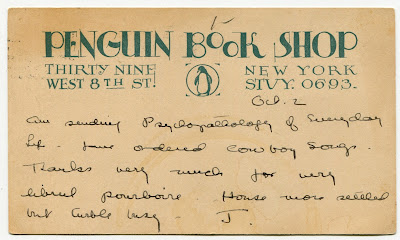Going Texan Book - Promotional Photo

Today is Go Texan Day in Houston. This annual event is ushered in with trail riders on horseback in a symbolic ride from points north, south, east, and west. These trail rides, which last from days to weeks, all converge in Houston's Memorial Park today. The trail riders and their parade through downtown Saturday, along with the World's Championship Bar-B-Que Contest at Reliant Park, kick off the Houston Livestock Show and Rodeo , a celebration of Western heritage and culture that officially starts March 2nd and will run through March 21st. When I was a kid in elementary school, we used to get Fat Stock Day as a holiday from school. That's how big a deal it was. They don't do that these days, but many folks still dress Western for work on this day, wearing their jeans, boots, and cowboy hats. Enough of that... this is about ephemera and, accordingly, I have a piece of ephemera related to the appropriate book for the occasion, Going Texan: The Days of the Houston Live...










